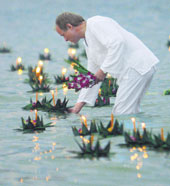 |
| LIKE A PRAYER: Family member of a tsunami victim releases traditional floating flowers with burning candles during a memorial service at Phuket |
It was a fistful of grey sediment, scooped out from the ocean floor some five kilometres below sea level, that held the answer which had eluded the world for a year. And Indian marine biologist Baban Ingole was among the first to know.
Around eight in the morning of December 26, 2004 ? the day when the tsunami swept away close to three lakh lives in south and south-east Asia ? an earthquake measuring 9.2 on the Richter Scale burst open 1,200 km of a fault line between the Indian and Asian tectonic plates near the Sumatran coast. The rupture pushed up a length of an undersea mountain range, causing some 200 trillion tonnes of water to ripple outward faster than a jet plane. In a matter of minutes, the tsunami had hit the coast of Banda Aceh near Indonesia, triggering the worst natural disaster to have hit mankind in recent times.
Scary figures, those. But until recently, anyone attempting to string them together had only frustration to stare at. Simply because the real cause of the tsunami ? or the first frame of the storyboard ? remained unknown to the world’s scientific fraternity. For months after the disaster, it debated whether the surge had been caused by a gigantic underwater landslide or a vertical shift of a part of the sea bed. The Sumatran earthquake could have caused either.
“It was to find this very answer that we had set out on the mission,” says Baban Ingole, a senior scientist at the National Institute of Oceanography, Goa. “For 17 days, we were to scan the depths of the Indian Ocean in search of the truth. And in the end, there it was, in that heap of sediment,” says the only Asian in a 27-member team that came together for an expedition to the earthquake’s epicentre.
Funded by media houses Discovery Channel and the BBC, the Sumatran Earthquake and Tsunami Offshore Survey kicked off from the Thai island of Phuket on May 9. The team members ? leading seismologists, geophysicists, biologists and tsunami modellers from across the world ? were raring to go, and together made up a bunch that Ingole found “amazing to work with”. For some, the area to be studied was familiar territory. Most, however, had never been there before.
The first week of the expedition didn’t throw up any conclusive evidence. And then came the red herring. The remote operated vehicle (ROV) used to photograph the sea bed picked up images of a massive landslide under the sea, big enough to have caused the tsunami. But no one knew if it had happened on December 26.
“We were very excited,” recalls Ingole. And very divided too, for many in the team still believed that the tsunami did not owe its origin to the landslide. The acid test involved checking a sample of sediment collected from the site for marine life. “Any area on the sea bed which remains undisturbed for years is bound to be teeming with marine life,” explains Ingole.
The sample did show the presence of life, indicating that the landslide had happened many years ago. Seven days of hard work had gone in vain; one lobby had conceded defeat. “Also, it meant having to start from scratch,” says Ingole.
Then, two days later, the ROV sent back images of a length of rockface standing upright on the sea bed. The edges of the cliff were saw-toothed, an indication that it had been chipped away by seismic activity. A sample was collected from the site, and Ingole turned on the microscope. This time, they were bang on target.
 |
What actually happened: |
• For millions of years, the plate under the Indian Ocean (1) gradually moved east, pushing the Asian plate (2) moving west. Over the years, the upper plate bent down like a springboard. • Pressure built in between the plates (3) along the fault line, which lay directly below an undersea chain of mountains. • The earthquake caused the Asian plate to move outward, pushing the entire chain of mountains up by almost 40 feet. • The vertical shift of the mountains caused a massive displacement of water, which travelled outward in the form of the tsunami. |
Successive calculations showed the ridge to be an extension of the mountain chain that lay several hundred kilometres along the fault line. While the vertical displacement of the mountains was about 10 feet, scientists combined measurements obtained from other cliffs to calculate a total vertical shift of about 40 feet.
But the Sumatran earthquake had ripped apart only half of the faultline running along the mountains. Another great quake could well displace what the former earthquake didn’t.
And that could mean bad news. “While our findings would help tsunami modellers across the world improve their designs and work out better precautionary measures in the event of another tsunami, it has to be remembered that India’s coastline, stretching over 7,000 km, is exposed to hazards,” says Ingole.
That’s enough reason for concern. And experts warn that there’s no telling as to when the next tsunami might come. “An earthquake is not predictable,” says geophysicist Harsh Gupta of the National Geophysical Research Institute, Hyderabad. “Moreover, only an earthquake measuring above eight on the Richter Scale has the power to unleash a tsunami, provided it happens in a tsunami-prone area where the water column is deep enough to register oscillations and leads to a displacement of water. It’s only when all these factors coincide that a tsunami is possible, but all that can’t be predicted in advance.”
The only way to gear up against the phenomenon is by getting in place a warning system that alerts scientists about the advent of a tsunami. “We already have gauges that measure depths in different parts of the Indian Ocean, and are putting in place underwater sensors which can measure the pressure of a propagating tsunami wave,” says an official in the Central government’s department of ocean development. “When the entire scheme is completed, we will have an effective system that can warn us of an imminent tsunami. But since a tsunami travels extremely fast, the efficiency of the system would always remain subjective to the proximity of an earthquake to our shores.”
Apprehensions apart, a study of the forces of nature always generates interest. The journey to the Sumatran depths, for one, has been made into a film to be aired on Discovery Channel this evening. “It’s fantastic,” is what Ingole has to say about it. In all probability, that’s what viewers across India would say too, regardless of the few unhappy episodes it might cause to flood back into public memory.










